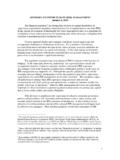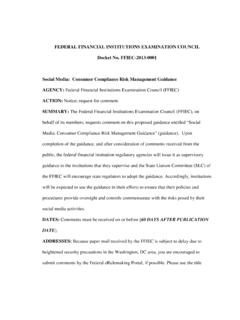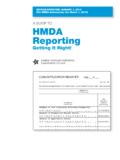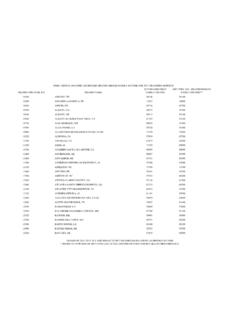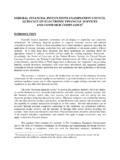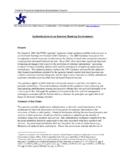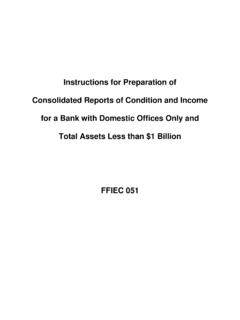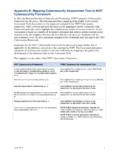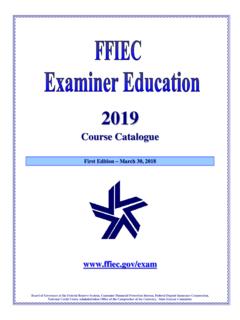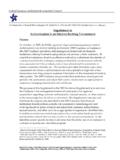Transcription of MONEY LAUNDERING RED FLAGS - FFIEC Home Page
1 MONEY LAUNDERING RED FLAGS DEPOSIT ACCOUNTS This document lists various transactions and activities that may indicate potential MONEY LAUNDERING . While not all-inclusive, the list does reflect ways that launderers have been known to operate. Transactions or activities listed here may not necessarily be indicative of MONEY LAUNDERING if they are consistent with a customer s legitimate business. Also, many of the red FLAGS involve more than one type of transaction. 1. Minimal, vague or fictitious information provided. An individual provides minimal, vague or fictitious information that the bank cannot readily verify. 2. Lack of references or identification. An individual attempts to open an account without references or identification, gives sketchy information, or refuses to provide the information needed by the bank. 3. Non-local address. The individual does not have a local residential or business address, and there is no apparent legitimate reason for opening an account with the bank.
2 4. Customers with multiple accounts. A customer maintains multiple accounts at a bank or at different banks for no apparent legitimate reason. The accounts may be in the same names or in different names with different signature authorities. Inter-account transfers are evidence of common control. 5. Frequent deposits or withdrawals with no apparent business source. The customer frequently deposits or withdraws large amounts of currency with no apparent business source, or the business is of a type not known to generate substantial amounts of currency. 6. Multiple accounts with numerous deposits under $10,000. An individual or group opens a number of accounts under one or more names, and makes numerous cash deposits just under 10,000, or deposits containing bank checks or travelers checks. 7. Numerous deposits under $10,000 in a short period of time. A customer makes numerous deposits under $10,000 in an account in short periods of time, thereby avoiding the requirement to file a Currency Transaction Report.
3 This includes deposits made at an automatic teller machine. 8. Accounts with a high volume of activity and low balances. Accounts with a high volume of activity, which carry low balances or are frequently overdrawn, may be indicative of MONEY LAUNDERING or check kiting. 9. Large deposits and balances. A customer makes large deposits and maintains large balances with little or no apparent justification. 10. Deposits and immediate requests for wire transfers or cash shipments. A customer makes numerous deposits in an account and almost immediately requests wire transfers or a cash shipment from that account to another account, possibly in another country. These transactions are not consistent with the customer s legitimate business needs. Normally, only a token amount remains in the original account. 11. Numerous deposits of small incoming wires or monetary instruments, followed by a large outgoing wire.
4 Numerous small incoming wires and/or multiple monetary instruments are deposited into an account. The customer then requests a large outgoing wire to another institution or country. 12. Accounts used as a temporary repository for funds. The customer appears to use an account as a temporary repository for funds that ultimately will be transferred out of the bank, sometimes to foreign-based accounts. There is little account activity. 13. Funds deposited into several accounts, transferred to another account, and then transferred outside of the This involves the deposit of funds into several accounts, which are then combined into one account, and ultimately transferred outside the This activity is usually not consistent with the known legitimate business of the customer. 14. Disbursement of certificates of deposit by multiple bank checks. A customer may request disbursement of the proceeds of a certificate of deposit or other investments in multiple bank checks, each under $10,000.
5 The customer can then negotiate these checks elsewhere for currency. He/she avoids the currency transaction reporting requirements and severs the paper trail. 15. Early redemption of certificates of deposits. A customer may request early redemption of certificates of deposit or other investments within a relatively short period of time from the purchase date of the certificate of deposit or investment. The customer may be willing to lose interest and incur penalties as a result of the early redemption. 16. Sudden, unexplained increase in account activity or balance. There may be a sudden, unexplained increase in account activity, both from cash and from non-cash items. An account may be opened with a nominal balance that subsequently increases rapidly and significantly. 17. Limited use of services. Frequent large cash deposits are made by a corporate customer, who maintains high balances but does not use the bank s other services.
6 18. Inconsistent deposit and withdrawal activity. Retail businesses may deposit numerous checks, but there will rarely be withdrawals for daily operations. 19. Strapped currency. Frequent deposits of large amounts of currency, wrapped in currency straps that have been stamped by other banks. 20. Client, trust and Escrow accounts. Substantial cash deposits by a professional customer into client accounts, or in-house company accounts, such as trust and escrow accounts. 21. Large amount of food stamps. Unusually large deposits of food stamps, which may not be consistent with the customer s legitimate business.
